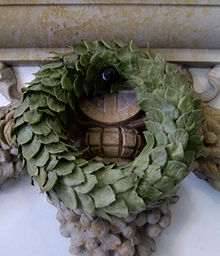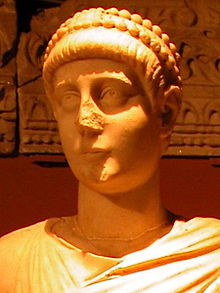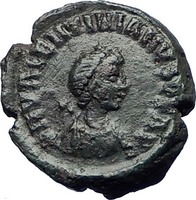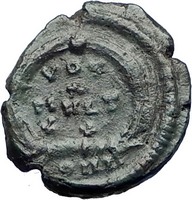Valentinian II - Roman Emperor: 375-392 A.D.
Bronze AE4 14mm (1.71 grams) Thessalonica mint 378-383 A.D.
Reference: RIC 77a (Constantinopolis), C 72
DNVALENTINIANVSPFAVG - Diademed, draped and cuirassed bust right.
No legend Exe: CON - Wreath, VOT/X/MVLT/XX within. You are bidding on the exact item pictured, provided with a Certificate of Authenticity and Lifetime Guarantee of Authenticity.
 The wreath was a symbol of victory in ancient Greek and Roman times, and references to it are still used in modern English language, as some may term it to be a "victory wreath." A laurel wreath, oak wreath or wreath is a circular wreath made of interlocking branches and leaves of the bay laurel (as in laurel wreath) (Laurus nobilis, Lauraceae), an aromatic broadleaf evergreen; or branches and leaves of other plants. In Greek mythology, Apollo is represented wearing a laurel wreath on his head. A wreath made of oak has connections to Jupiter, the Roman equivalent of Zeus, as his sacred tree was the oak. In ancient Greece wreaths were awarded to victors, both in athletic competitions, including the ancient Olympics made of wild olive-tree known as "kotinos" (κότινος), (sc. at Olympia) and in poetic meets; in Rome they were symbols of martial victory, crowning a successful commander during his triumph. The wreath was a symbol of victory in ancient Greek and Roman times, and references to it are still used in modern English language, as some may term it to be a "victory wreath." A laurel wreath, oak wreath or wreath is a circular wreath made of interlocking branches and leaves of the bay laurel (as in laurel wreath) (Laurus nobilis, Lauraceae), an aromatic broadleaf evergreen; or branches and leaves of other plants. In Greek mythology, Apollo is represented wearing a laurel wreath on his head. A wreath made of oak has connections to Jupiter, the Roman equivalent of Zeus, as his sacred tree was the oak. In ancient Greece wreaths were awarded to victors, both in athletic competitions, including the ancient Olympics made of wild olive-tree known as "kotinos" (κότινος), (sc. at Olympia) and in poetic meets; in Rome they were symbols of martial victory, crowning a successful commander during his triumph.
The wreath symbol was used often on ancient Greek and Roman coins. The wreath on ancient Roman coins is often depicted being held by Jupiter's (Zeus') sacred bird, the eagle, and also Victory (Nike) and by other deities less often; and many coins with emperors depicted wearing it; and at times, entire designs being surrounded by a wreath. In common modern idiomatic usage it refers to a victory. The expression "resting on one's laurels" refers to someone relying entirely on long-past successes for continued fame or recognition, where to "look to one's laurels" encourages an individual to take inspiration from past achievements to conquer a fresh task.
 Valentinian II - 375-392 A.D. Valentinian II - 375-392 A.D.
375-383 A.D. Junior Augustus (with Gratian)
383-392 A.D. Sole reign
Ruling in the East: Valens (364-378 A.D.), Theodosius I (379-395 A.D.) and Arcadius (383-408 A.D.) | Son of Valentinian I (and Justina) | Brother of Galla (wife of Theodosius I) | Half-brother of Gratian | Nephew of Valens | Brother-in-law of Theodosius I | Flavius Valentinianus (371 - 15 May 392), known usually by his anglicised name, Valentinian II, was a Roman Emperor from 375 to 392. Early Life and Accession (371-375)Flavius Valentinianus was born to Emperor Valentinian I and his second wife, Justina. He was the half-brother of Valentinian's other son, Gratian, who had shared the imperial title with his father since 367. He had three sisters Galla, Grata and Justa. The elder Valentinian died on campaign in Pannonia in 375. Neither Gratian (then in Trier) nor his uncle Valens (emperor for the East) were consulted by the army commanders on the scene. Instead of merely acknowledging Gratian as his father's successor, Valentinian I's generals acclaimed the four-year old boy augustus on 22 November 375. The army may have been uneasy about Gratian's lack of military ability, and so raised a boy who would not immediately aspire to military command. Reign from Milan (375-387)Gratian, forced to accommodate the generals who supported his half-brother, governed the trans-alpine provinces (including Gaul, Hispania, and Britain), while Italy, part of Illyricum, and Africa were under the rule of Valentinian. In 378, their uncle, the Emperor Valens, was killed in battle with the Goths at Adrianople, and Gratian invited the general Theodosius to be emperor in the East. As a child, Valentinian II was under the influence of his Arian mother, the Empress Justina, and the imperial court at Milan, an influence contested by the Catholic bishop of Milan, Ambrose. Justina used her influence over her young son to oppose the Catholic party which was championed by Ambrose. In 385 Ambrose, backed by Milan's populace, refused an imperial request to hand over the Portian basilica for the use of Arian troops. In 386 Justina and Valentinian received the Arian bishop Auxentius, and Ambrose was again ordered to hand over a church in Milan for Arian usage. Ambrose and his congregation barricaded themselves inside the church, and the imperial order was rescinded. Magnus Maximus used the emperor's heterodoxy against him, and even his eventual protector, Theodosius, cast aspersions on his Arianism. Valentinian also tried to restrain the despoiling of pagan temples in Rome. Buoyed by this instruction, the pagan senators, led by Aurelius Symmachus, the Prefect of Rome, petitioned in 384 for the restoration of the Altar of Victory in the Senate House, which had been removed by Gratian in 382. Valentinian, at the insistence of Ambrose, refused the request and, in so doing, rejected the traditions and rituals of pagan Rome to which Symmachus had appealed. In 383, Magnus Maximus, commander of the armies in Britain, declared himself Emperor and established himself in Gaul and Hispania. Gratian died while fleeing him. For a time the court of Valentinian, through the mediation of Ambrose, came to an accommodation with the usurper, and Theodosius recognized Maximus as co-emperor of the West. However, in 386 or 387, Maximus crossed the Alps into the Po valley and threatened Milan. Valentinian II and Justina fled to Theodosius in Thessalonica. The latter came to an agreement, cemented by his marriage to Valentinian's sister Galla, to restore the young emperor in the West. In 388, Theodosius marched west and defeated Maximus. Although he was to appoint both of his sons emperor (Arcadius in 383, Honorius in 393), Theodosius remained loyal to the dynasty of Valentinian I. After the defeat of Maximus, Theodosius remained in Milan until 391. Valentinian took no part in Theodosius' triumphal celebrations over Maximus. Valentinian and his court were installed at Vienne in Gaul, while Theodoisus appointed key administrators in the West, and had coins minted which implied his guardianship over the 17 year old. Justina had already died, and Vienne was far away from the influence of Ambrose. Theodosius' trusted general, the Frank Arbogast, was appointed magister militum for the Western provinces (bar Africa) and guardian of Valentinian. Acting in the name of Valentinian, Arbogast was actually subordinate only to Theodosius. While the general campaigned successfully on the Rhine, the young emperor remained at Vienne, in contrast to his warrior father and his older brother, who had campaigned at his age. Arbogast's domination over the emperor was considerable, and the general even murdered Harmonius, a friend of Valentinian suspected of taking bribes, in the emperor's presence. The crisis reached a peak when Arbogast prohibited the emperor from leading the Gallic armies into Italy to oppose a barbarian threat. Valentinian, in response, formally dismissed Arbogast. The latter ignored the order, publically tearing it up and arguing that Valentinian had not appointed him in the first place. The reality of where the power lay was openly displayed. Valentinian wrote to Theodosius and Ambrose complaining of his subordination to his general. In explicit rejection of his earlier Arianism, he invited Ambrose to come to Vienne to baptize him. However, on 15 May 392, Valentinian was found hanged in his residence in Vienne. Arbogast maintained that the emperor's death was suicide. While our main source, Zosimus writing in the early sixth century from Constantinople, states that the Frank had Valentinian murdered, ancient authorities are divided in their opinion. The young man's body was conveyed in ceremony to Milan for burial by Ambrose, mourned by his sisters Justa and Grata. The bishop's eulogy is the only contemporary Western source for Valentinian's death. It is ambiguous on the question of the emperor's death, which is not surprising, as Ambrose represents him as a model of Christian virtue. Suicide, not murder, would make Ambrose dissemble on this key question. At first Arbogast recognized Theodosius's son Arcadius as emperor in the West, seemingly surprised by his charge's death. After three months, during which he had no communication from Theodosius, Arbogast selected an imperial official, Eugenius, as emperor. Theodosius initially tolerated this regime but, in January 393, elevated the eight year old Honorius as augustus to succeed Valentinian II. Civil war ensued and, in 394, Theodosius defeated Eugenius and Arbogast. SignificanceValentinian himself seems to have exercised no real authority, and was a figurehead for various powerful interests: his mother, his co-emperors, and powerful generals. Since the Crisis of the Third CenturyDiocletian and his collegiate system. While Constantine and his sons had been strong military figures, they had also re-established the practice of hereditary succession, adopted by Valentinian I. The obvious flaw in these two competing requirements came in the reign of Valentinian II, a child. His reign was a harbinger of the fifth century, when children or nonentities, reigning as emperors, were controlled by powerful generals and officials.
|


 The wreath was a symbol of victory in ancient Greek and Roman times, and references to it are still used in modern English language, as some may term it to be a "victory wreath." A laurel wreath, oak wreath or wreath is a circular wreath made of interlocking branches and leaves of the bay laurel (as in laurel wreath) (Laurus nobilis, Lauraceae), an aromatic broadleaf evergreen; or branches and leaves of other plants. In Greek mythology, Apollo is represented wearing a laurel wreath on his head. A wreath made of oak has connections to Jupiter, the Roman equivalent of Zeus, as his sacred tree was the oak. In ancient Greece wreaths were awarded to victors, both in athletic competitions, including the ancient Olympics made of wild olive-tree known as "kotinos" (κότινος), (sc. at Olympia) and in poetic meets; in Rome they were symbols of martial victory, crowning a successful commander during his triumph.
The wreath was a symbol of victory in ancient Greek and Roman times, and references to it are still used in modern English language, as some may term it to be a "victory wreath." A laurel wreath, oak wreath or wreath is a circular wreath made of interlocking branches and leaves of the bay laurel (as in laurel wreath) (Laurus nobilis, Lauraceae), an aromatic broadleaf evergreen; or branches and leaves of other plants. In Greek mythology, Apollo is represented wearing a laurel wreath on his head. A wreath made of oak has connections to Jupiter, the Roman equivalent of Zeus, as his sacred tree was the oak. In ancient Greece wreaths were awarded to victors, both in athletic competitions, including the ancient Olympics made of wild olive-tree known as "kotinos" (κότινος), (sc. at Olympia) and in poetic meets; in Rome they were symbols of martial victory, crowning a successful commander during his triumph. 

